|
. . . . AND THOSE AROUND TRING
CHAPTER II.
TYPES OF WINDMILL
Setting aside prairie wind pumps, wind turbines and other recent
developments, traditional windmills fall into three broad
categories, the ‘post mill’, the ‘smock mill’ and the ‘tower mill’.
POST MILLS

|
Fig. 2.1: A post
mill could be revolved around its central trestle to
face the sails into the wind using the tail pole
(protruding at the rear), an action called “winding”.
This open trestle post mill stood on Bledlow Ridge near
Chinnor. It was damaged and ceased working
in 1913, and was pulled down in 1933. |
Post mills were the earliest type of windmill to reach Britain,
probably late in the 12th century. They are so named because the
body of the mill is supported on and revolves around an upright
post. This enables the mill to be turned to face into the wind ― a
task called winding or luffing ― where its sails can generate the
most torque. [2] Many examples remain throughout Western Europe, those
at Pitstone (plate 1), at Brill (plate 4) and at Chinnor (plate 7)
being nearest to Tring.
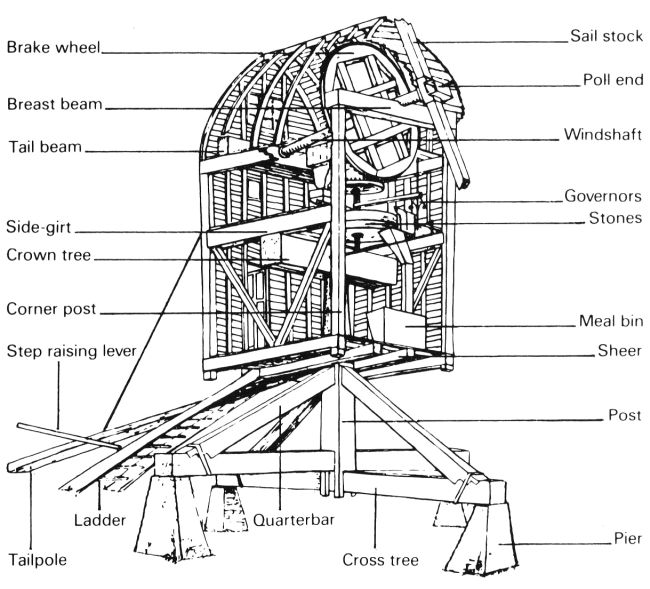
Fig. 2.2: the parts of an open
trestle post mill
The mill’s supporting post needs to be a substantial piece of timber
to carry the weight of the mill’s superstructure and machinery. That
which supports Pitstone mill was cut from a single tree, some 17
feet long by 33 inches diameter at its base, comparable in girth to
a sailing ship’s mast. The post is capped with a bearing,
which permits rotation and, via a massive wooden
cross-beam called the ‘crown tree’, supports the full weight of the
mill.
In fig. 2.2, the post appears to rest upon the cross-trees beneath
it, but this is not so. Were it to be, the entire weight of the mill
would bear down on their centre, which would eventually fracture
under the pressure. Thus, the post is suspended slightly above the
cross-trees by four ‘quarter bars’, which are mortised into it and
which also maintain its vertical position. By this means the mill’s
weight is transferred downwards evenly through each of the quarter
bars and onto the four
brick piers. The cross-trees, which are held in a permanent state of
tension by the outward thrust of the mill’s weight, prevent the
quarter bars from spreading, a clever resolution of forces.
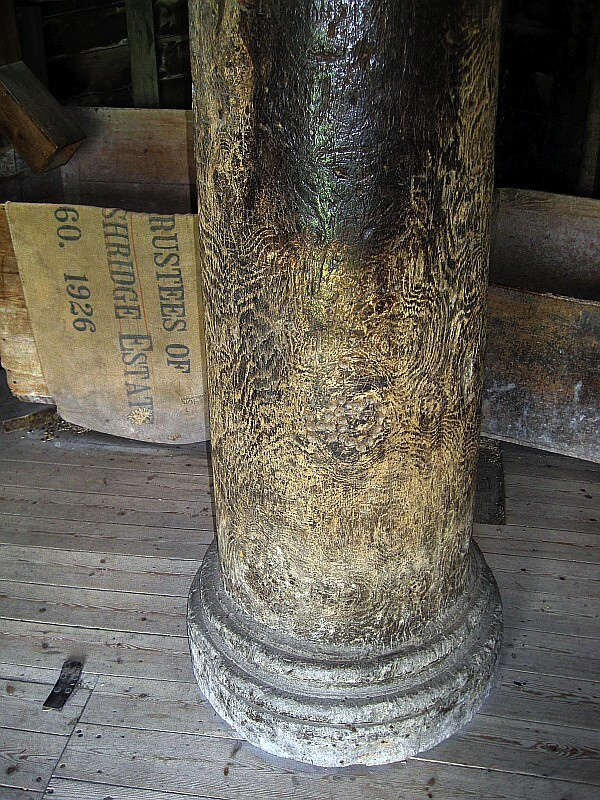
Fig 2.3: main post, Pitstone
Mill, Buckinghamshire
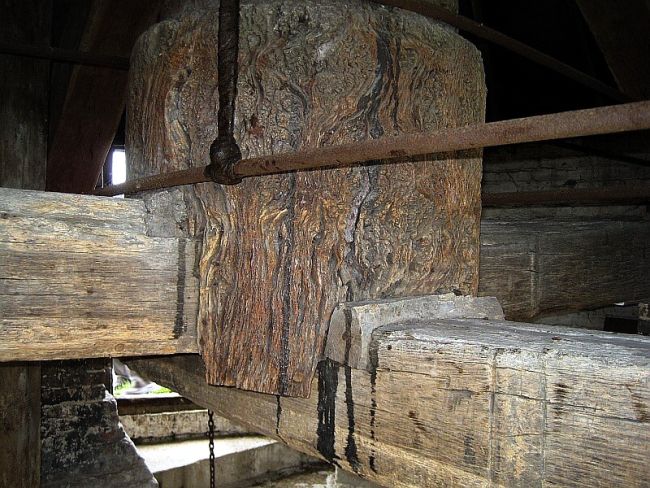
Fig. 2.4: base of main post and cross
trees, Pitstone post mill, Buckinghamshire
Many post mills eventually had a brick roundhouse built about their
base (plate 4) to protect their timber supports from the
weather and to provide a covered loading bay. Those without a
roundhouse are usually described as ‘open trestle’.
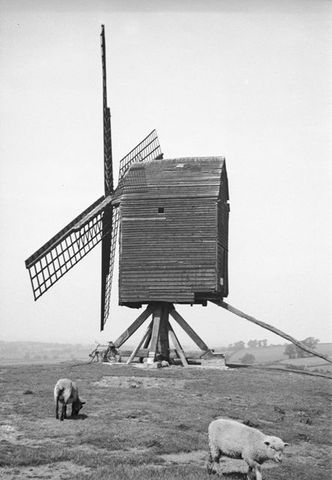
Fig. 2.5: open trestle post mill at
Brill -
it later acquired a
roundhouse
SMOCK MILLS
Due to its distinctive sloping sides, usually six or eight in
number, this type of windmill came to be named after the canvas and
cotton smocks worn by farm labourers of the time. As with the
earlier post mill, the sides of a smock mill are clad with
horizontal weatherboarding, although there are some examples of
vertical cladding. The mill’s wooden body sits on a brick base to
protect it against rot and to provide support for its upright posts. The base can be a substantial structure, that supporting Union Mill
(fig. 2.6) being a four-storey building.
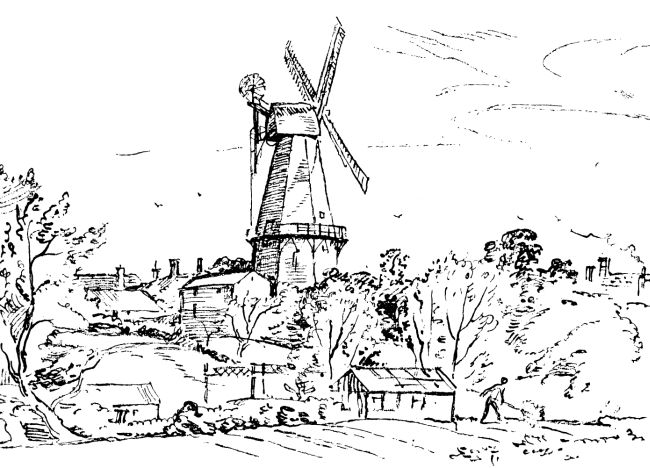
Fig. 2.6: Union Mill, Cranbrook,
Kent, Britain’s tallest smock mill -
built in 1814, it is now open to the public
The main internal structure of a smock mill consists of its cant or
corner posts (plate 11), which extend to its full height, converging
as they go up. The cant posts are secured at the bottom to a wooden
sill, which is fixed firmly to the brick base. This joint between
post and sill poses a problem; because the cant posts lean inwards
they throw the mill’s weight outwards at the sill, where a weak
joint can result in posts slipping away and toppling the mill.
Unlike the post mill, in which the whole body of the mill needs to
be turned to wind its sails, only the top, or cap, of a smock mill
needs to rotate. The small cap also allows better airflow around the
sails, which contributes to a more efficient and stable source of
power, especially when winding is performed automatically by a small
windmill at the rear of the cap known as a fantail (see fig. 2.6).
Because the body of the
mill doesn’t have to be rotated, it can be larger than a post mill, thus allowing
more space for machinery.
Smock mills are found throughout Western Europe; in the U.K. they
were particularly common in Kent. The nearest smock mill to Tring is
at Lacey Green near Princes Risborough (Chapter
XII.).
TOWER MILLS
|
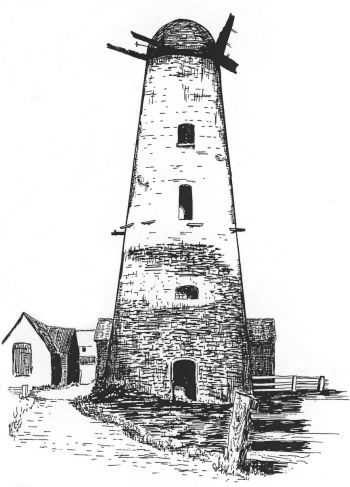 |
|
Fig. 2.7: Quainton tower
mill prior to restoration |
The earliest record of a tower mill in Britain dates from the late
13th century and refers to a mill at Dover, possibly at the Castle.
In that age, windmills were sometimes built on the sides of castles
and of towers in fortified towns to protect them from attack.
A tower mill differs from a smock mill in that it is of brick or
stone construction and usually round in shape, although there is a
fine example of an octagonal tower mill at Wendover (plate 22). Because of its masonry construction, a tower mill requires
increasingly massive walls towards its base to support the weight of
the upper storeys; those at Wendover mill are three feet thick at
the base. It is therefore unsurprising that tower mills were much
more expensive to construct than wooden post and smock mills, and
probably for this reason they did not become prevalent until the
18th and 19th centuries. However, this type of construction offers
the advantage of a more robust frame that can support larger sails
and resist harsher weather.
In common with the smock mill, the tower mill is topped by a
moveable cap, that at Stembridge Tower Mill at High Ham, Somerset,
being the last example of a thatched cap.
The nearest tower mill to Tring is Goldfield Mill (Chapter
VIII) on Icknield Way, near to the junction with Miswell Lane. Slightly
further afield are examples of tower mills at Hawridge (Chapter
IX)
and at Wendover (Chapter X). These three mills have been converted into private
dwellings, but the tower mill at Quainton (Chapter
XI) has been restored to
working order and is open to the public. |